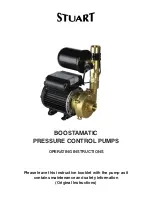
SECTION D: MAINTENANCE INSTRUCTIONS
1.
Keep interior of pump and valves clean. When pumping liquids containing foreign materials, flush out
pump with clear water whenever possible.
2.
Keep suction hose air tight and check for leaks and loose lining, as these are major trouble sources
when priming.
3.
Valves and valve weights must be straight, seat well and have no cracks.
4.
The capacity of a diaphragm pump will vary greatly depending on the height of the suction lift and
length of discharge line. A discharge line which is too small, long or high will cause:
A. Excessive bulging of diaphragm on down stroke.
B. Valves closing with loud snap.
C. Rough operation.
D. Engine overloads and slows down.
E. Reduced capacity.
5.
Check all bolts frequently and keep them drawn up tightly.
6.
TO CHANGE DIAPHRAGM:
A. Rotate connecting rod and crank to down position.
B. Remove four bolts at outer edge to take off water box.
C. Remove three bolts at connecting rod and take out diaphragm.
D. Replace diaphragm with type designed for heavy duty service as originally supplied
with pump. Raised ridges on diaphragm must fit in grooves in connecting rod and bottom
clamp plate. Insert three bolts and draw up nuts snug.
E. Center diaphragm carefully over water box and clamp with four bolts to pump frame.
7.
TO CHANGE VALVE RUBBERS:
A. Remove suction and discharge connections and remove valve rubbers.
B. Place new valve rubber between weight and binder and insert and tighten 2 screws that
hold them together. Tighten firmly but not so rubber is distorted, causing poor seating.
C. Dowel pin in suction connection and on discharge side of waterbox must enter hole in
valve rubber to locate valve in correct relation to valve opening.
8.
Diaphragm pumps will handle fluids containing considerable solids, however if mixture is too heavy to
be pumped, liquid must be added until it becomes sufficiently fluid for pumping.
9.
Neoprene and other rubbers can be furnished for the diaphragm and valve rubbers when pumping
fluids containing considerable oils, greases or chemicals.
10. ENCLOSED GEAR CASE:
Change the transmission oil after the first 40 hours of operation. Use an SAE80 -90 wt. EP gear lube.
Capacity is 20 oz. (550ml). Fill to the oil level plug in the transmission cover. Check oil level periodically
and change oil every 400 hours.
11. Change engine oil per manufacturer’s specifications. Check oil level frequently.
8
Содержание 2CDG3
Страница 10: ...10...






































